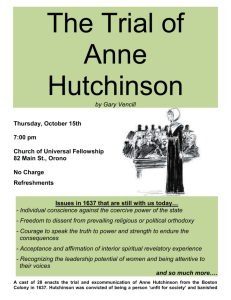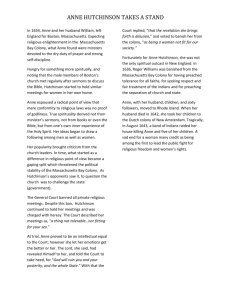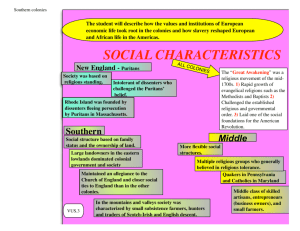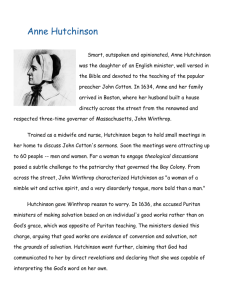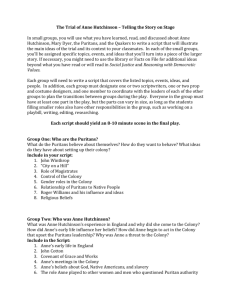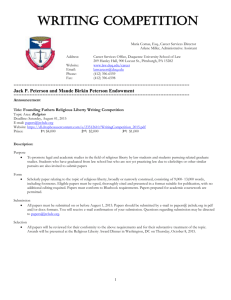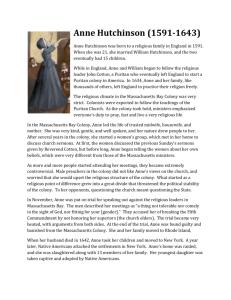Lesson Plan Template
advertisement
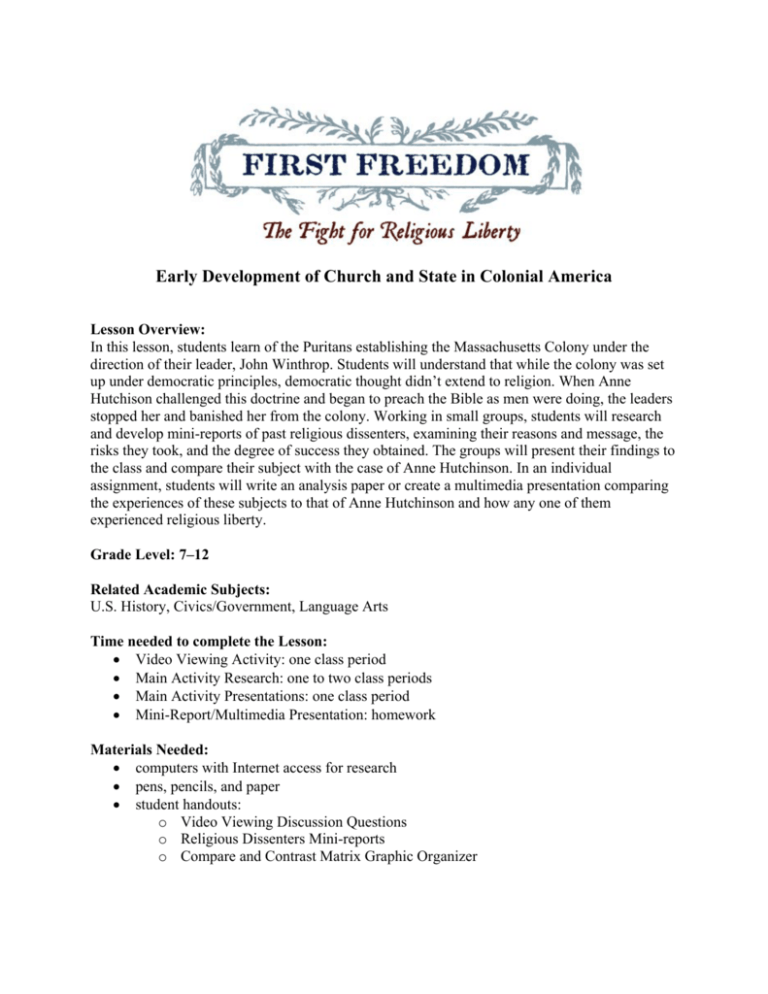
Early Development of Church and State in Colonial America Lesson Overview: In this lesson, students learn of the Puritans establishing the Massachusetts Colony under the direction of their leader, John Winthrop. Students will understand that while the colony was set up under democratic principles, democratic thought didn’t extend to religion. When Anne Hutchison challenged this doctrine and began to preach the Bible as men were doing, the leaders stopped her and banished her from the colony. Working in small groups, students will research and develop mini-reports of past religious dissenters, examining their reasons and message, the risks they took, and the degree of success they obtained. The groups will present their findings to the class and compare their subject with the case of Anne Hutchinson. In an individual assignment, students will write an analysis paper or create a multimedia presentation comparing the experiences of these subjects to that of Anne Hutchinson and how any one of them experienced religious liberty. Grade Level: 7–12 Related Academic Subjects: U.S. History, Civics/Government, Language Arts Time needed to complete the Lesson: • Video Viewing Activity: one class period • Main Activity Research: one to two class periods • Main Activity Presentations: one class period • Mini-Report/Multimedia Presentation: homework Materials Needed: • computers with Internet access for research • pens, pencils, and paper • student handouts: o Video Viewing Discussion Questions o Religious Dissenters Mini-reports o Compare and Contrast Matrix Graphic Organizer Lesson Objectives: The student will: • Understand the formation of the Massachusetts Colony under Puritan principles and the extent of religious liberty • Explain why Anne Hutchinson’s actions ran afoul of the colony’s leadership • Compare and contrast various examples of religious dissenters in history • Analyze whether the dissenters experienced religious liberty Video Segments Used in the Lesson: Video Segment 1: “A City upon a Hill” Description: By 1630, the Puritans had set up a colony in Massachusetts to practice their own form of Christianity without interference from king or pope. Though they established democratic communities, they did not allow any serious dissent to their beliefs. Faith in God was absolute and could not deviate from what the Bible said or what the leaders said it said. When Anne Hutchison challenged this doctrine and began to preach the Bible as men were doing, the leaders stopped her and banished her from the colony. This incident presented one of the major tests for any democracy: Can a society that seeks religious freedom for itself also extend it to others who don’t believe the same way? Lesson Procedure Opening Activity: The Nature of Religious Liberty Most of us believe we understand what religious liberty means and that it is part of the U.S. Constitution, embodied in the First Amendment of the Bill of Rights. However, as students will discover during the First Freedom unit, religious liberty is not an absolute freedom and poses many unanswered questions. This opening activity does not try to establish any definitive answers to the question “What is religious liberty?”—rather it tries to broaden the discussion surrounding the meaning of religious liberty and its application in a democratic society. 1. Place students into Think-Pair-Share groups and ask them to think about the importance of religion in society. Have them identify some of the advantages and disadvantages that religion brings to a society. Then ask various pair-groups for their ideas and list them on the front board. Now have them read the definition of religious liberty: Religious Liberty: the freedom of an individual or community to practice, worship, or observe any religion of choice in public or private. It is also generally recognized that religious liberty means the freedom to change religions or not follow any religion. 2. Ask the following questions: • What freedom does religious liberty grant members of a society? • Does religious liberty allow followers to practice a religious act that might bring harm to themselves or worshippers? • • Does religious liberty allow individuals to wear religious clothing or jewelry that reflects their religious beliefs even if others find it offensive? Does religious liberty allow individual to disregard or break a law in the practice of their religion? 3. Hold a discussion of the extent of religious liberty Should people be free to practice their religion any way they want? Think of examples where the right of individuals to practice their religion might be restricted. Do you think that restrictions are sometimes necessary? Why or why not? Video Viewing Activity – The Fight for Religious Liberty Tell students that this video segment presents the story of the Massachusetts Colony, led by John Winthrop. It shows how the Puritans established a colony that practiced some degree of democracy, but did not extend democracy to religion. Anne Hutchinson would test that limitation and pay the price. 1. Organize students into small groups. 2. Distribute the student handout, “Early Development of Church and State in Colonial America – Video Viewing Discussion Questions” to all students. 3. Allow time for students to view Video Segment 1: “A City Upon a Hill” 4. Have students discuss the Small Group Questions first. 5. Have them meet as a full class and review the questions randomly with the groups. 6. Discuss the “Class Discussion Questions” with the entire class. Main Lesson: Religious dissenters have tested the extent of society’s tolerance for as long as religion has existed. In this activity, students will examine several religious dissenters throughout history and compare their similarities and differences to each other and to the case of Anne Hutchinson. Before starting this activity, review the dissenters presented in the student handout “Religious Dissenters.” Select the ones you feel appropriate for your class. 1. 2. 3. 4. Organize students into small research groups and assign one dissenter to each group. Distribute the student handout to all groups and review with students. Provide time for students to prepare their mini-reports. When students are ready to present their reports, distribute the “Compare and Contrast Matrix Graphic Organizer” to all students. 5. As student groups present their reports, have them record data on the graphic organizer. 6. For the group assessment, have each group summarize how their subject’s experiences compared to that of Anne Hutchinson in the areas mentioned on the matrix. 7. Have students formulate an analysis paper or create a multimedia presentation comparing the experiences of these subjects to that of Anne Hutchinson in the four areas mentioned on the matrix. Highlight subjects who you feel experienced religious liberty and explain why. Students can produce traditional presentations (on construction or butcher paper, bulletin boards or poster boards) or a digital presentation of slides, blog posts, or web pages. Assessment: Use the suggested rubric provided or your own assessment tool to evaluate student work on the mini-reports. Resources: • The Heritage Foundation: “The Meaning of Religious Liberty” http://www.heritage.org/research/reports/2007/12/the-meaning-of-religious-liberty • Brookings Institute: “Religious Pluralism is an American Tradition http://www.brookings.edu/research/opinions/2007/07/26islamicworld-amr • First Amendment Schools: http://www.firstamendmentschools.org/ • The Gilder Lehrman Institute: The Puritans and Dissent: The Case of Roger Williams and Anne Hutchinson http://www.gilderlehrman.org/history-by-era/religion-and-eighteenthcentury-revivalism/essays/puritans-and-dissent-cases-roger-wi • U.S. History.org http://www.ushistory.org/us/3.asp Standards: McREL: http://www.mcrel.org/compendium/browse.asp U.S. History: • Standard 1: Understands the characteristics of societies in the Americas, Western Europe, and Western Africa that increasingly interacted after 1450 • Standard 4: Understands how political, religious, and social institutions emerged in the English colonies Civics: • Standard 9: Understands the importance of Americans sharing and supporting certain values, beliefs, and principles of American constitutional democracy • Standard 13: Understands the character of American political and social conflict and factors that tend to prevent or lower its intensity • Standard 25: Understands issues regarding personal, political, and economic rights Language Arts: Writing Standard 1: Uses the general skills and strategies of the writing process Standard 2: Uses grammatical and mechanical conventions in written compositions Standard 3: Gathers and uses information for research purposes Listening and Speaking Standard 7: Uses listening and speaking strategies for different purposes Thinking and Reasoning Standard 1: Understands and applies the basic principles of presenting and making an argument About the Author: Greg Timmons has been a social studies teacher for more than 30 years. He has written lessons for several PBS productions, including THE NEWS HOUR, FRONTLINE, and various Ken Burns productions, including THE WAR, THE NATIONAL PARKS: AMERICA’s BEST IDEA, THE TENTH INNING, PROHIBITION and THE DUST BOWL. He resides in Washington state and Montana. Student Handout: Early Development of Church and State in Colonial America Video Viewing Discussion Questions Video Clip: “City upon a Hill” Small Group Questions: Review the video segment and discuss the following questions in your small group: • Why did the Puritans leave England for Massachusetts? What was their goal once they arrived in North America? • What was John Winthrop’s main message to his fellow Puritans as they departed for Massachusetts? • According to Winthrop, what role did God play in the success of the Puritan colony? • Winthrop once said, “A democracy is accounted the meanest and worst of all forms of government.” Why do you think he had such a low opinion of democracy? • What was the infraction Anne Hutchison allegedly committed? • Why did Winthrop and the other Puritans believe Hutchison’s actions were a threat to the colony? • Do you think banishing Anne Hutchinson was the only option Winthrop and the elders had? What might be another option? Support your answer. Class Discussion Questions: • Which do you think the Puritans were trying to establish, religious liberty or the freedom to practice their own form of Christianity? In the case of the Puritans, what was the difference between the two? • The program’s historians describe the belief held by many early Americans that America was God’s favorite. If this were true, what did they feel they had to do in return? Explain how this notion makes people feel about their relationship to God and their place in history. • The early founders of America understood that establishing a civilization and government would be challenging in America. They believed God was on their side, but knew that much of the success lay in their hands. Why would dissent be considered unhealthy in the Puritan colony, and how does the suppression of dissent reconcile with democracy? Student Handout: Religious Dissenters Mini-Reports Background: Religious dissent can come in many forms. Sometimes it is individuals who practice a different belief system than the majority of society. Other times, dissent involves challenging the actions of religious leaders because some feel they are corrupt or have deviated from the religion’s original beliefs. In the case of Anne Hutchinson, she challenged the authority of the elders as the only ones qualified to interpret the Bible. Dissenters aren’t always dissenting for the betterment of society or to improve the religion. Sometimes they dissent for personal reasons. Similar to revolutionaries, who are considered heroes by their followers and terrorists by those against whom they are revolting, some religious dissenters were considered blasphemers or fools by their critics and saints by their followers. Below are examples of religious dissenters from different periods of history. After your group has been assigned one of these dissenters, conduct research following the guide below and construct a small report to present to the class. This can be a traditional presentation (on construction or butcher paper, bulletin boards or poster boards) or a digital presentation of slides, blog posts, or web pages. Dissenters: • Savonarola (1452–1498) • Martin Luther (1483–1546) • Roger Williams (1603–1683) • Elijah Craig (1738/1743–1808) • Charles Finney (1792–1875) • Joseph Smith (1805–1844) • Mary Baker Eddy (1821–1910) • Robert Ingersoll (1833–1899) • Madalyn Murray O’Hair (1919–1995) Questions for Report: • Brief background on your subject (place of birth, life, and death; occupation; main activities) • What was the reason for your subject’s dissent from established religion? • What was the message your subject was trying to promote? • What was the risk your subject took in trying to promote his or her view of religion? • Was your subject successful in his or her endeavors? Explain. Student Handout: Compare and Contrast Matrix Graphic Organizer Directions: Take notes during the presentations on the following subjects in the categories listed. When all presentations are completed, compare and contrast the subjects to the experience of Anne Hutchinson. Subject Reasons for Dissent Message Promoted Risk Taken Level of Success Savonarola (1452–1498) Martin Luther (1483–1546) Roger Williams (1603–1683) Elijah Craig (1738/1743– 1808) Charles Finney (1792–1875) Joseph Smith (1805– 1844) Mary Baker Eddy (1821– 1910) Robert Ingersoll (1833–1899) Madalyn Murray O’Hair (1919–1995) Group Assessment: Summarize how your subject’s experiences compared to those of Anne Hutchison in the four areas listed in the matrix. Individual Assessment: Formulate an analysis comparing the experiences of these subjects to that of Anne Hutchinson in the four areas mentioned above. Highlight people who you feel experienced religious liberty and explain why. You may use information from other parts of this lesson. You can produce a traditional presentation (on construction or butcher paper, bulletin boards or poster boards) or a digital presentation of slides, blog posts, or web pages. Mini-Report Presentation Rubric Early Development of Church and State in Colonial America Student Name ___________________________________________ THE ESSAY CATEGORY 4 3 2 1 Content Shows a full Shows a good Shows a good Does not seem to understanding of understanding of understanding of understand the the topic. the topic. parts of the topic. topic very well. Preparedness Student is completely prepared and has obviously rehearsed. Student seems pretty prepared but might have needed a couple more rehearsals. Student is somewhat prepared, but it is clear that rehearsal was lacking. Student does not seem at all prepared to present. Organization Information is very organized with wellconstructed paragraphs and subheadings. Information is organized with well-constructed paragraphs. Information is organized, but paragraphs are not well constructed. Information appears to be disorganized. Quality of Information Information clearly relates to the main topic. It includes several supporting details and/or examples. Information clearly relates to the main topic. It provides 1–2 supporting details and/or examples. Information clearly relates to the main topic. No details and/or examples are given. Information has little or nothing to do with the main topic. SUBTOTAL _________ out of 16 pts. WRITING QUALITY Mechanics No grammatical, spelling, or punctuation errors. Almost no grammatical, spelling, or punctuation errors A few grammatical, spelling, or punctuation errors. Many grammatical, spelling, or punctuation errors. Diagrams and Illustrations Diagrams and illustrations are neat and accurate and add to the reader’s understanding of the topic. Diagrams and illustrations are accurate and add to the reader’s understanding of the topic. SUBTOTAL Diagrams and illustrations are neat and accurate and sometimes add to the reader’s understanding of the topic. Diagrams and illustrations are not accurate OR do not add to the reader’s understanding of the topic. _________ out of 8 pts. ORAL PRESENTATION SKILLS (Timeline Activity) CATEGORY 4 3 2 1 Speaks Clearly Speaks clearly and distinctly all (100–95%) the time, and mispronounces no words. Speaks clearly and distinctly all (100–95%) the time, but mispronounces one word. Speaks clearly and distinctly most (94–85%) of the time. Mispronounces no more than one word. Often mumbles or cannot be understood OR mispronounces more than one word. Posture and Eye Contact Stands up straight, looks relaxed and confident. Establishes eye contact with everyone in the room during the presentation. Stands up straight and establishes eye contact with everyone in the room during the presentation. Sometimes stands up straight and establishes eye contact. Slouches and/or does not look at people during the presentation. SUBTOTAL TOTAL _________ out of 8 pts. ________ out of 32 pts.
